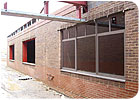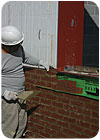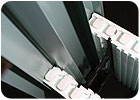
The long-term benefits of ICFs played a major factor in the decision by the Franklin County Board of Education in Kentucky to choose the concrete and foam building system for its new elementary school last year.
“Our education clients set numerous goals and priorities for new school construction,” explained Project Architect Kenny Stanfield, of the firm Sherman Carter Barnhart, PSC. The firm designed the Franklin school and is finalizing plans for another educational facility that promises to be among the largest ICF buildings in the United States.

Brick masons have an easy time continuing their work when they come to the steel opening.
THREE GOALS FROM SCHOOLS
“Three goals that we hear frequently are: ‘We want a highly energy-efficient facility, a strong building structure to resist storms, and we want a strategy that shortens the building delivery.’ We recognize and present ICFs to our clients as a viable option because it satisfies each of these goals with a single building system,” Stanfield added.The single-story school is 67,000 square feet and has space for more than 23 classrooms. It required 26,000 square feet of ICF walls. The bearing height for the roofing system was 12 feet, and several ICF gables reached a height of 26 feet. It was built with a geothermal heating and cooling system.
The project was built by Alliance Corp. of Glasgow, Ky., using Amvic ICFs. The ICF installer was The Atlas Co., a large commercial construction firm with three decades of distribution and sub-contracting experience, based in Louisville, Ky.
A unique part of the project was the use of a pour-in-place integrated steel door and window assembly that dramatically cut construction time, with resultant savings in labor. Stala Integrated Assemblies, LLC. , invented the unique framing in broad consultation with ICF manufacturers to eliminate the use of wood in framing commercial ICF openings and to simplify the overall ICFs construction process.
“Wood just isn’t the right product to properly frame an ICF opening,” said Kip Stutterheim, Atlas’ field project manager for the Franklin school. “We saved a lot of time not having carpenters install the wood bucking, then dealing with the problems of some of the bucking sagging or getting out of plumb. There’s a lot of work involved to get a wood opening true. On a commercial project with 100, or 1,000 openings, that’s a lot of expensive extra time.”
The steel assemblies are manufactured by Stala Integrated Assemblies, LLC. “Stala” is the acronym for “Systems To Assemble, Link and Align ICF Construction.”

The assemblies are customized to fit the dimensions of specific brands of ICFs. Shown is an assembly with Amvic ICF blocks.
CUSTOM ENGINEERING
Stala General Manager David Morris said the 14-gauge units for each project are engineered from architectural drawings, and then shipped to the jobsite. Because the assembly for each opening is custom designed for absolute precision, installation is exceedingly easy compared to traditional methods. “We’re not restricted by size. When openings are larger than commercial truck trailers, we can still offer our solution,” he said.Stutterheim said placing the window assemblies at the Franklin project was almost as easy as it sounds. “All we had to do was figure the left and right dimensions where the assemblies had to go.” The openings were 12 feet wide and 6 feet high. Each weighed about 220 pounds and was placed with a forklift. “We knew the assemblies went two-courses high on the ICFs, and once they were placed, we could slide them by hand when needed to fine-tune or adjust their location.”
The window assemblies include built-in recessed vibrator pockets at windowsills, which ensure good concrete placement and consolidation, a must in ICF construction.
After a Stala assembly is placed, more ICF block is set around the unit to build up the wall. Since the units are customizable for every ICF manufacturer’s unique product, a secure fit is assured and snaking minimized. “One interesting thing we have noticed is that these units, since they are so rigid, help to keep the walls straight during the concrete pour. Too often wood gives out during the construction process,” Stutterheim said.
Morris said a key goal of the Stala design process was to coordinate the work of seven trades on site. These included foundations, masons, drywallers, door and hardware suppliers, window manufacturers, the general contractor and ICF installer.
BRICKS AND DRYWALL
“Brick masons weren’t slowed down when they came to one of the openings,” Stutterheim said. “The openings were true and plum. The brick just comes up and butts to it, covering up the air space on the wall. The masons don’t have to turn the bricks, so it saved a lot of time.”On the interior walls the assemblies have a finished drywall channel that looks much like finished casework. The drywall slides under the return, requiring no trim work or molding. “In conventional drywall finishing at ICF openings, corner-guard and other materials are usually used at doors/windows,” Morris said. “This means extra money and labor for the owners.”
Stutterheim noted that the door assemblies come to the jobsite “already prepped for hardware and there’s no concrete where the preps go. We didn’t have to drill out where the hardware preps go, which is really time-consuming.” He said the door assemblies were ready to be used to secure the building the day they were installed.
And perhaps, Stutterheim said, one of the most delightful aspects of the project was watching the ease in which the aluminum windows were installed. “We always had a consistent opening, each time. Sometimes with wood there is sagging and the window guy will have a bear of a job getting that window in there. We had none of that on this job.”
Stutterheim said the simplicity of the project gave him the flexibility to work ahead of his crew. “I was able to think ahead and focus on embeds, truss-bearing plates. It made things a lot more fluid.”
“Our ICFs crew was mobilized at the end of August/early September and we were finished in early December,” Stutterheim said. “The time savings from the traditional methods saved us several weeks.”

Report Abusive Comment